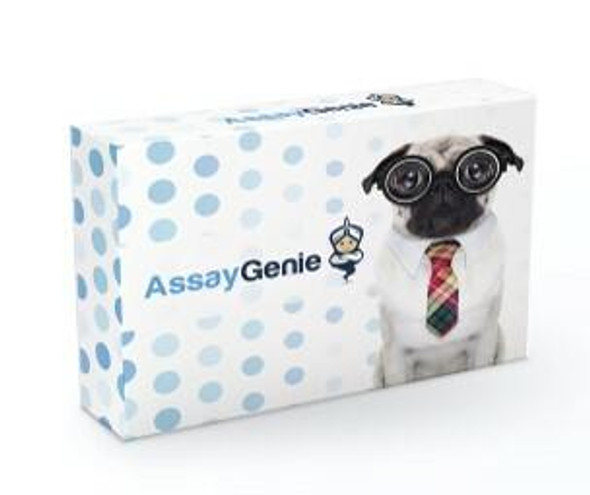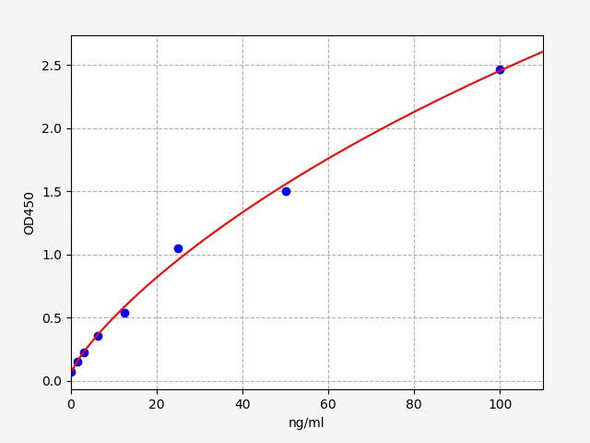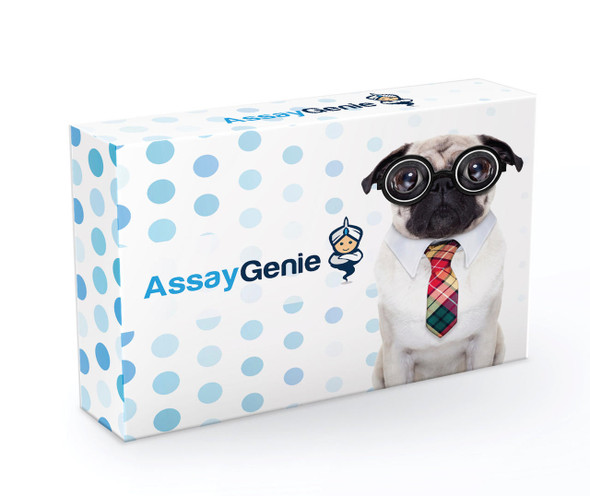Human MMP 2 ELISA Kit (HUFI00017)
- SKU:
- HUFI00017
- Product Type:
- ELISA Kit
- Size:
- 96 Assays
- Uniprot:
- P08253
- Sensitivity:
- 0.191ng/ml
- Range:
- 0.5-32ng/ml
- ELISA Type:
- Sandwich
- Synonyms:
- MMP-2, Matrix Metalloproteinase 2, Gelatinase A, 72 kDa gelatinase, CLG4, collagenase type IV-A, 72 kDa type IV collagenase
- Reactivity:
- Human
- Research Area:
- Cardiovascular
Description
Human MMP 2 ELISA Kit
The Human MMP-2 ELISA Kit is a specialized assay designed for the precise measurement of matrix metalloproteinase-2 levels in human biological samples such as serum, plasma, and cell culture supernatants. This kit offers exceptional sensitivity and specificity, ensuring accurate and reproducible results for a variety of research applications.Matrix metalloproteinase-2 (MMP-2) is a key enzyme involved in tissue remodeling and extracellular matrix degradation.
It plays a critical role in processes such as wound healing, cell migration, and invasion, making it a valuable biomarker for studying conditions such as cancer, inflammation, and cardiovascular diseases. The Human MMP-2 ELISA Kit provides researchers with a powerful tool for investigating the role of MMP-2 in disease progression and developing targeted therapies.
| Product Name: | Human MMP 2 ELISA Kit |
| Product Code: | HUFI00017 |
| Size: | 96 Assays |
| Alias: | MMP-2, Matrix Metalloproteinase 2, Gelatinase A, 72 kDa gelatinase, CLG4, collagenase type IV-A, 72 kDa type IV collagenase |
| Detection method: | Sandwich ELISA, Double Antibody |
| Application: | This immunoassay kit allows for the in vitro quantitative determination of Human MMP-2 concentrations in serum plasma and other biological fluids. |
| Sensitivity: | 0.191ng/ml |
| Range: | 0.5-32ng/ml |
| Storage: | 4°C for 6 months |
| Note: | For Research Use Only |
| Recovery: | Matrices listed below were spiked with certain level of Human MMP-2 and the recovery rates were calculated by comparing the measured value to the expected amount of Human MMP-2 in samples. | ||||||||||||||||
| |||||||||||||||||
| Linearity: | The linearity of the kit was assayed by testing samples spiked with appropriate concentration of Human MMP-2 and their serial dilutions. The results were demonstrated by the percentage of calculated concentration to the expected. | ||||||||||||||||
| |||||||||||||||||
| CV(%): | Intra-Assay: CV<8% Inter-Assay: CV<10% |
| Component | Quantity | Storage |
| ELISA Microplate (Dismountable) | 8×12 strips | 4°C for 6 months |
| Lyophilized Standard | 2 | 4°C/-20°C |
| Sample/Standard Dilution Buffer | 20ml | 4°C |
| Biotin-labeled Antibody(Concentrated) | 120ul | 4°C (Protect from light) |
| Antibody Dilution Buffer | 10ml | 4°C |
| HRP-Streptavidin Conjugate(SABC) | 120ul | 4°C (Protect from light) |
| SABC Dilution Buffer | 10ml | 4°C |
| TMB Substrate | 10ml | 4°C (Protect from light) |
| Stop Solution | 10ml | 4°C |
| Wash Buffer(25X) | 30ml | 4°C |
| Plate Sealer | 5 | - |
Other materials and equipment required:
- Microplate reader with 450 nm wavelength filter
- Multichannel Pipette, Pipette, microcentrifuge tubes and disposable pipette tips
- Incubator
- Deionized or distilled water
- Absorbent paper
- Buffer resevoir
| Uniprot | P08253 |
| UniProt Protein Function: | MMP2: Ubiquitinous metalloproteinase that is involved in diverse functions such as remodeling of the vasculature, angiogenesis, tissue repair, tumor invasion, inflammation, and atherosclerotic plaque rupture. As well as degrading extracellular matrix proteins, can also act on several nonmatrix proteins such as big endothelial 1 and beta-type CGRP promoting vasoconstriction. Also cleaves KISS at a Gly-|-Leu bond. Appears to have a role in myocardial cell death pathways. Contributes to myocardial oxidative stress by regulating the activity of GSK3beta. Cleaves GSK3beta in vitro. Interacts (via the C-terminal hemopexin-like domains- containing region) with the integrin alpha-V/beta-3; the interaction promotes vascular invasion in angiogenic vessels and melamoma cells. Interacts (via the C-terminal PEX domain) with TIMP2 (via the C-terminal); the interaction inhibits the degradation activity. Interacts with GSK3B. Aspirin appears to inhibit expression. Produced by normal skin fibroblasts. PEX is expressed in a number of tumors including gliomas, breast and prostate. Inhibited by histatin-3 1/24 (histatin-5). Belongs to the peptidase M10A family. |
| UniProt Protein Details: | Protein type:Secreted; Motility/polarity/chemotaxis; Cell development/differentiation; Protease; Apoptosis; EC 3.4.24.24; Secreted, signal peptide Chromosomal Location of Human Ortholog: 16q12.2 Cellular Component: extracellular space; proteinaceous extracellular matrix; sarcomere; mitochondrion; extracellular region; plasma membrane; nucleus Molecular Function:protein binding; zinc ion binding; serine-type endopeptidase activity; metalloendopeptidase activity Biological Process: extracellular matrix disassembly; collagen catabolic process; axon guidance; extracellular matrix organization and biogenesis; intramembranous ossification; cellular protein metabolic process; positive regulation of innate immune response; ephrin receptor signaling pathway; response to hypoxia; angiogenesis; proteolysis; blood vessel maturation; embryo implantation Disease: Multicentric Osteolysis, Nodulosis, And Arthropathy |
| NCBI Summary: | This gene is a member of the matrix metalloproteinase (MMP) gene family, that are zinc-dependent enzymes capable of cleaving components of the extracellular matrix and molecules involved in signal transduction. The protein encoded by this gene is a gelatinase A, type IV collagenase, that contains three fibronectin type II repeats in its catalytic site that allow binding of denatured type IV and V collagen and elastin. Unlike most MMP family members, activation of this protein can occur on the cell membrane. This enzyme can be activated extracellularly by proteases, or, intracellulary by its S-glutathiolation with no requirement for proteolytical removal of the pro-domain. This protein is thought to be involved in multiple pathways including roles in the nervous system, endometrial menstrual breakdown, regulation of vascularization, and metastasis. Mutations in this gene have been associated with Winchester syndrome and Nodulosis-Arthropathy-Osteolysis (NAO) syndrome. Alternative splicing results in multiple transcript variants encoding different isoforms. [provided by RefSeq, Oct 2014] |
| UniProt Code: | P08253 |
| NCBI GenInfo Identifier: | 116856 |
| NCBI Gene ID: | 4313 |
| NCBI Accession: | P08253.2 |
| UniProt Secondary Accession: | P08253,Q9UCJ8, B2R6U1, B4DWH3, E9PE45, |
| UniProt Related Accession: | P08253 |
| Molecular Weight: | 68,831 Da |
| NCBI Full Name: | 72 kDa type IV collagenase |
| NCBI Synonym Full Names: | matrix metallopeptidase 2 (gelatinase A, 72kDa gelatinase, 72kDa type IV collagenase) |
| NCBI Official Symbol: | MMP2 |
| NCBI Official Synonym Symbols: | CLG4; MONA; CLG4A; MMP-2; TBE-1; MMP-II |
| NCBI Protein Information: | 72 kDa type IV collagenase; gelatinase A; 72 kDa gelatinase; collagenase type IV-A; neutrophil gelatinase; matrix metalloproteinase-2; matrix metalloproteinase-II |
| UniProt Protein Name: | 72 kDa type IV collagenase |
| UniProt Synonym Protein Names: | 72 kDa gelatinase; Gelatinase A; Matrix metalloproteinase-2; MMP-2; TBE-1Cleaved into the following chain:PEX |
| Protein Family: | Matrix metalloproteinase |
| UniProt Gene Name: | MMP2 |
| UniProt Entry Name: | MMP2_HUMAN |
*Note: Protocols are specific to each batch/lot. For the correct instructions please follow the protocol included in your kit.
Before adding to wells, equilibrate the SABC working solution and TMB substrate for at least 30 min at 37 °C. When diluting samples and reagents, they must be mixed completely and evenly. It is recommended to plot a standard curve for each test.
| Step | Protocol |
| 1. | Set standard, test sample and control (zero) wells on the pre-coated plate respectively, and then, record their positions. It is recommended to measure each standard and sample in duplicate. Wash plate 2 times before adding standard, sample and control (zero) wells! |
| 2. | Aliquot 0.1ml standard solutions into the standard wells. |
| 3. | Add 0.1 ml of Sample / Standard dilution buffer into the control (zero) well. |
| 4. | Add 0.1 ml of properly diluted sample ( Human serum, plasma, tissue homogenates and other biological fluids.) into test sample wells. |
| 5. | Seal the plate with a cover and incubate at 37 °C for 90 min. |
| 6. | Remove the cover and discard the plate content, clap the plate on the absorbent filter papers or other absorbent material. Do NOT let the wells completely dry at any time. Wash plate X2. |
| 7. | Add 0.1 ml of Biotin- detection antibody working solution into the above wells (standard, test sample & zero wells). Add the solution at the bottom of each well without touching the side wall. |
| 8. | Seal the plate with a cover and incubate at 37 °C for 60 min. |
| 9. | Remove the cover, and wash plate 3 times with Wash buffer. Let wash buffer rest in wells for 1 min between each wash. |
| 10. | Add 0.1 ml of SABC working solution into each well, cover the plate and incubate at 37 °C for 30 min. |
| 11. | Remove the cover and wash plate 5 times with Wash buffer, and each time let the wash buffer stay in the wells for 1-2 min. |
| 12. | Add 90 µL of TMB substrate into each well, cover the plate and incubate at 37 °C in dark within 10-20 min. (Note: This incubation time is for reference use only, the optimal time should be determined by end user.) And the shades of blue can be seen in the first 3-4 wells (with most concentrated standard solutions), the other wells show no obvious color. |
| 13. | Add 50 µL of Stop solution into each well and mix thoroughly. The color changes into yellow immediately. |
| 14. | Read the O.D. absorbance at 450 nm in a microplate reader immediately after adding the stop solution. |
When carrying out an ELISA assay it is important to prepare your samples in order to achieve the best possible results. Below we have a list of procedures for the preparation of samples for different sample types.
| Sample Type | Protocol |
| Serum | If using serum separator tubes, allow samples to clot for 30 minutes at room temperature. Centrifuge for 10 minutes at 1,000x g. Collect the serum fraction and assay promptly or aliquot and store the samples at -80°C. Avoid multiple freeze-thaw cycles. If serum separator tubes are not being used, allow samples to clot overnight at 2-8°C. Centrifuge for 10 minutes at 1,000x g. Remove serum and assay promptly or aliquot and store the samples at -80°C. Avoid multiple freeze-thaw cycles. |
| Plasma | Collect plasma using EDTA or heparin as an anticoagulant. Centrifuge samples at 4°C for 15 mins at 1000 × g within 30 mins of collection. Collect the plasma fraction and assay promptly or aliquot and store the samples at -80°C. Avoid multiple freeze-thaw cycles. Note: Over haemolysed samples are not suitable for use with this kit. |
| Urine & Cerebrospinal Fluid | Collect the urine (mid-stream) in a sterile container, centrifuge for 20 mins at 2000-3000 rpm. Remove supernatant and assay immediately. If any precipitation is detected, repeat the centrifugation step. A similar protocol can be used for cerebrospinal fluid. |
| Cell culture supernatant | Collect the cell culture media by pipette, followed by centrifugation at 4°C for 20 mins at 1500 rpm. Collect the clear supernatant and assay immediately. |
| Cell lysates | Solubilize cells in lysis buffer and allow to sit on ice for 30 minutes. Centrifuge tubes at 14,000 x g for 5 minutes to remove insoluble material. Aliquot the supernatant into a new tube and discard the remaining whole cell extract. Quantify total protein concentration using a total protein assay. Assay immediately or aliquot and store at ≤ -20 °C. |
| Tissue homogenates | The preparation of tissue homogenates will vary depending upon tissue type. Rinse tissue with 1X PBS to remove excess blood & homogenize in 20ml of 1X PBS (including protease inhibitors) and store overnight at ≤ -20°C. Two freeze-thaw cycles are required to break the cell membranes. To further disrupt the cell membranes you can sonicate the samples. Centrifuge homogenates for 5 mins at 5000xg. Remove the supernatant and assay immediately or aliquot and store at -20°C or -80°C. |
| Tissue lysates | Rinse tissue with PBS, cut into 1-2 mm pieces, and homogenize with a tissue homogenizer in PBS. Add an equal volume of RIPA buffer containing protease inhibitors and lyse tissues at room temperature for 30 minutes with gentle agitation. Centrifuge to remove debris. Quantify total protein concentration using a total protein assay. Assay immediately or aliquot and store at ≤ -20 °C. |
| Breast Milk | Collect milk samples and centrifuge at 10,000 x g for 60 min at 4°C. Aliquot the supernatant and assay. For long term use, store samples at -80°C. Minimize freeze/thaw cycles. |
| Sara Gouarderes et al. | Pulsed Electric Fields Induce Extracellular Matrix Remodeling through Matrix Metalloproteinases Activation and Decreased Collagen Production | Journal of Investigative Dermatology 2022 | PubMed ID: 34688615 |
| Gouarderes et al. | Pulsed electric fields induce extracellular matrix remodeling through MMPs activation and decreased collagen production. | Journal of Investigative Dermatology 2022 | PubMed ID: 34688615 |







